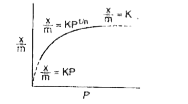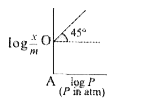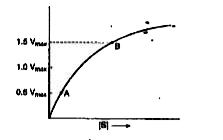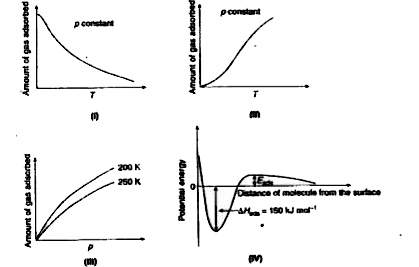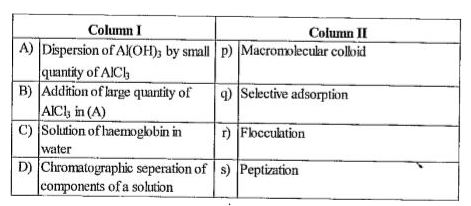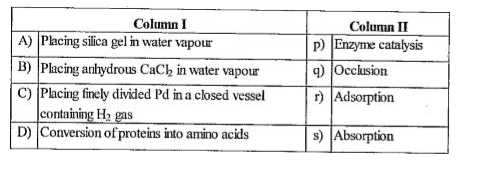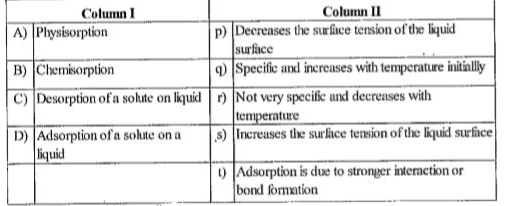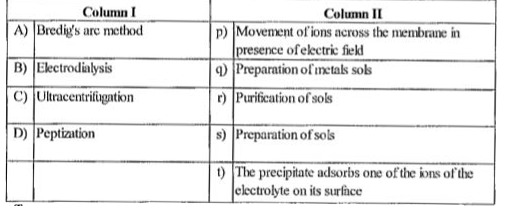LEVEL II from BRILLIANT PUBLICATION SURFACE CHEMISTRY for Class 12
| Class 12 | CHEMISTRY |
| Chapter | SURFACE CHEMISTRY |
| BRILLIANT PUBLICATION | LEVEL II |
| Medium | English |
| Academic Year | 2023-2024 |
Question 12
2.0 g of charcoal is placed in 100 mL of 0.5 M CH3COOH to form an adsorbed mono-acidic layer of acetic acid molecules and thereby the molarity of CH3 COOH reduces to 0.49. The surface area of charcoal is 3×102m2g−1. The surface area of charcoal adsorbed by each molecule of acetic acid is View SolutionQuestion 32
At 1 atm and 273 K the volume of nitrogen gas required to cover a sample of silica gel, assuming Langinuin monolayer adsorption, is found to be 1.30cm3g−1 of the gel. The area occupied by a nitrogen molecule is 0.16nm2. What is the surface area per gram of silica gel?
[Given : NA=6×1023]View SolutionQuestion 33
10% sites of catalyst bed have adsorbed by H2. On heating H2 gas is evolved from sites and collectedat 0.03 atm and 300 K in a small vessel of 2.46 cm3. No. of sites available is 5.4×1016 per cm2 and surfacearea is 1000 cm2. Find out the no. of surface sites occupied per molecule of H2:[GivenNA=6×1023]View SolutionQuestion 34
A sample of 16 g charcoal was brought into contact with CH gas contained in a vessel of 1 litre at 27∘C. The. pressure of gas was found to fall from 760 to 608 torr. The density of charcoal sample is 1.6g/cm3. What is the volume of the CH4 gas adsorbed per gram of the adsorbentat 608 torr and 27∘C ?View SolutionQuestion 52
Which of the following factors are respsonsible for the increase in the rate of a surface catalysed reaction?
I. A catalyst provides proper orientation for the reactant molecuels to react.
II. Heat of adsorption of reactants on a catalyst helps reactant molecules to overcome activation energy.
III. The catalyst increases the activation energy of the reaction.
IV. Adsorption increases the local concentration of reactant molecules on the surface of the catalyst. Select the correct answer using the codes given below: View SolutionQuestion 57
In a solution of 100 mL 0.5 M acetic acid, one g of active charcoal is added, which adsorbs acetic acid. It is found that the concentration of acetic acid becomes 0.49 M if surface area of charcoal is 3.01×102m2, calculate the area occupied by single acetic acid molecule on surface of charcoal.View SolutionQuestion 69
The mass adsorbed per gram of adsorbed O2 having pressure 10 atmosphere at 400 K, if placed in contact with solid surface is 2 grain in one litre vessel. The pressure of O2, after adsorption becomes 2 atmosphere. Assume no change in temperature and R=0.08 litre atmosphere K−mol−1 (ignore volume of adsorbent).View SolutionQuestion 70
20% surface sites have adsorbed N2 On heating N, gas is evolved from sites and were collected at 0.001 atm and 298 K in a container of volume 2.46cm3. Density of surface sites is 6.02×1014cm−2 and surface area is 1000 cm2 Find out the number of surface sites occupied per molecule of N2 .View SolutionQuestion 95
Substances which alter the velocity of a reaction by mere presence, without undergoing any change in mass and composition are termed catalysts and the phenomenon is known as catalysis.
In homogenous catalytic reactions, there are three alternative paths A, B and C (shown in figure). Which one of the following indicates the relative case with which the reaction can take place?
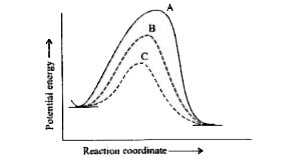 View Solution
View Solution
All Exercises from BRILLIANT PUBLICATION Class 12 CHEMISTRY SURFACE CHEMISTRY
- QUESTION
- QUESTIONS
- QUESTIONS (LEVEL - I) (HOMEWORK)
- LEVEL I
- QUESTIONS (LEVEL - II)
- QUESTIONS (LEVEL - II) (ASSERTION REASON TYPE QUESTIONS)
- LEVEL II
- LEVEL II (LINKED COMPREHENSION TYPE)
- LEVEL II (MATCHING COLUMN TYPE)
- LEVEL II (MULTIPLE CORRECT ANSWER TYPE)
- LEVEL II (NUMERICAL TYPE)
- LEVEL II (SINGLE CORRECT ANSWER TYPE)
- LEVEL II (STATEMETN TYPE)
